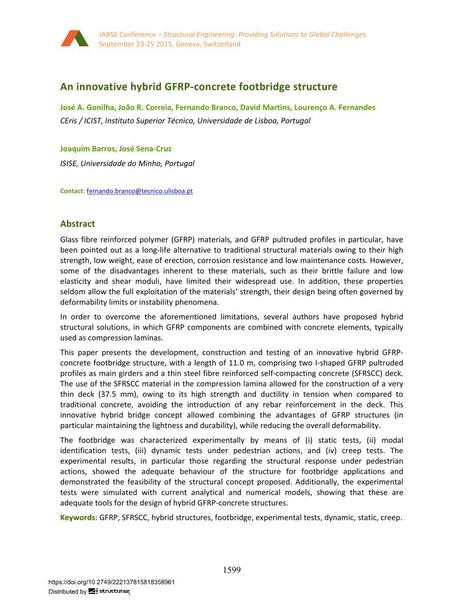An innovative hybrid GFRP-concrete footbridge structure

|
|
|||||||||||
Bibliographic Details
| Author(s): |
José A. Gonilha
(CEris / ICIST, Instituto Superior Técnico, Universidade de Lisboa, Portugal)
João R. Correia (CEris / ICIST, Instituto Superior Técnico, Universidade de Lisboa, Portugal) Fernando Branco (CEris / ICIST, Instituto Superior Técnico, Universidade de Lisboa, Portugal) David Martins (CEris / ICIST, Instituto Superior Técnico, Universidade de Lisboa, Portugal) Lourenço A. Fernandes (CEris / ICIST, Instituto Superior Técnico, Universidade de Lisboa, Portugal) Joaquim Barros (ISISE, Universidade do Minho, Portugal) José Sena-Cruz (ISISE, Universidade do Minho, Portugal) |
||||
|---|---|---|---|---|---|
| Medium: | conference paper | ||||
| Language(s): | English | ||||
| Conference: | IABSE Conference: Structural Engineering: Providing Solutions to Global Challenges, Geneva, Switzerland, September 2015 | ||||
| Published in: | IABSE Conference Geneva 2015 | ||||
|
|||||
| Page(s): | 1599-1606 | ||||
| Total no. of pages: | 8 | ||||
| Year: | 2015 | ||||
| DOI: | 10.2749/222137815818358961 | ||||
| Abstract: |
Glass fibre reinforced polymer (GFRP) materials, and GFRP pultruded profiles in particular, have been pointed out as a long-life alternative to traditional structural materials owing to their high strength, low weight, ease of erection, corrosion resistance and low maintenance costs. However, some of the disadvantages inherent to these materials, such as their brittle failure and low elasticity and shear moduli, have limited their widespread use. In addition, these properties seldom allow the full exploitation of the materials’ strength, their design being often governed by deformability limits or instability phenomena. In order to overcome the aforementioned limitations, several authors have proposed hybrid structural solutions, in which GFRP components are combined with concrete elements, typically used as compression laminas. This paper presents the development, construction and testing of an innovative hybrid GFRP- concrete footbridge structure, with a length of 11.0 m, comprising two I-shaped GFRP pultruded profiles as main girders and a thin steel fibre reinforced self-compacting concrete (SFRSCC) deck. The use of the SFRSCC material in the compression lamina allowed for the construction of a very thin deck (37.5 mm), owing to its high strength and ductility in tension when compared to traditional concrete, avoiding the introduction of any rebar reinforcement in the deck. This innovative hybrid bridge concept allowed combining the advantages of GFRP structures (in particular maintaining the lightness and durability), while reducing the overall deformability. The footbridge was characterized experimentally by means of (i) static tests, (ii) modal identification tests, (iii) dynamic tests under pedestrian actions, and (iv) creep tests. The experimental results, in particular those regarding the structural response under pedestrian actions, showed the adequate behaviour of the structure for footbridge applications and demonstrated the feasibility of the structural concept proposed. Additionally, the experimental tests were simulated with current analytical and numerical models, showing that these are adequate tools for the design of hybrid GFRP-concrete structures. |
||||
| Keywords: |
footbridge GFRP hybrid structures dynamic experimental tests creep static SFRSCC
|
||||


